Oculus Go Review
Oculus Go Review
The go-to device for a completely self-contained VR experience
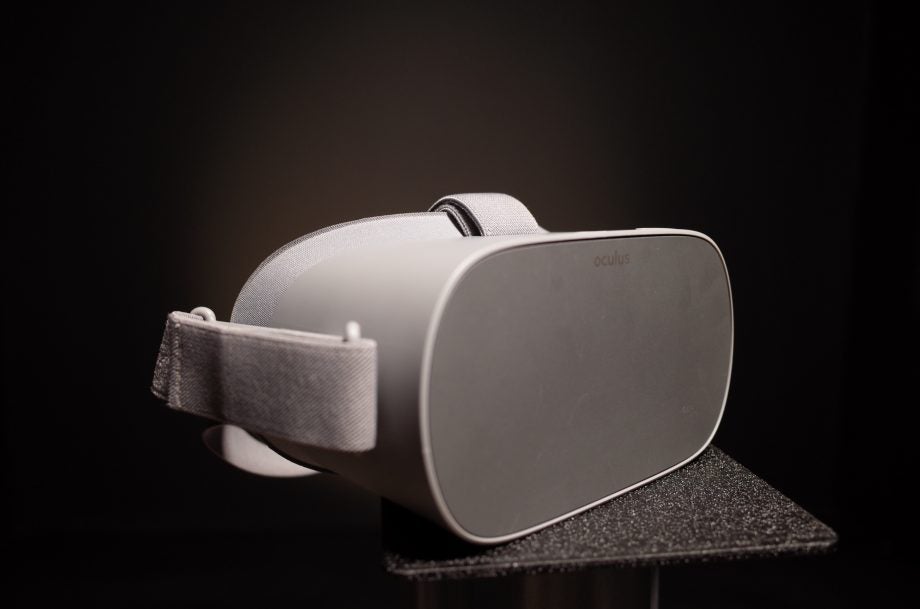
Verdict
Pros
- Decent screen resolution and refresh rate
- Tracking feels accurate
- Plenty of software available at launch
- Motion controller included as standard
Cons
- Battery life could be better
- No killer app
Key Specifications
- Review Price: £199
- 2560 x 1440 resolution screen
- 72Hz max refresh rate
- 467g weight
- 1000 apps available at launch, 100 updated for headset
- 2.5 hours of battery life
Updated: read our Oculus Quest review and Oculus Rift S review
The first time you try virtual reality, it’s hard not to be blown away by the sense of immersion, the feeling that for the first time you’re actually inhabiting a virtual world rather than just observing it from the other side of a screen.
But as anyone who’s spent the money on the likes of an Oculus Rift or HTC Vive can tell you, having to constantly nanny a hefty cable that tethers you to your PC isn’t very immersive at all.
That’s if you can even afford to buy a Rift or Vive in the first place. Both are pretty pricey pieces of hardware, and they’ll also need to be powered by a powerful standalone computer.
Related: Best VR games
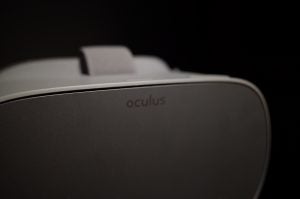
Oculus has a solution to the problem: the Oculus Go, a new headset that offers a completely self-contained VR experience. It’s wireless, meaning no need for a beefy gaming PC, and you don’t need to strap a phone into it like with other mobile VR solutions.
The company is selling the new headset for £199/$199, which is a fraction of the price of its PC VR siblings, and even cheaper than the budget console virtual reality offered by Sony with its PlayStation VR headset. A more expensive model that bumps the internal storage from 32GB to 64GB is available for £249/$249.
So is this a headset that has just a fraction of the functionality of its bigger brothers, or does it out-grow its budget form-factor?
Oculus Go – Design
The Oculus Go is a standalone VR headset, which means it doesn’t need a computer or console to run. There are some pretty significant benefits to this, but there are also some downsides.
Let’s start with the good stuff. Being standalone drastically reduces the cost of using an Oculus Go. Rather than the full-size Oculus Rift or competing HTC Vive, the Go doesn’t need a computer to run. As such, you won’t have to spend hundreds of pounds on a decently equipped PC, and nor will you have to be constantly connected to the tower via a hefty cable.
That said, there are some drawbacks. The Oculus Go is limited to tracking rotational movement, rather than knowing your position. This means it’s very good at knowing when your head is turning left, right, up or down, but it can’t determine if you’re moving forward or backward.
More expensive competitors include external tracking stations that can figure out the position of your head, but there’s none of that with the Oculus Go. It’s all completely self-contained.
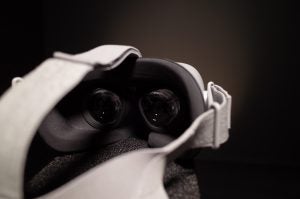
Every Oculus Go headset comes with a motion-controller. This is nowhere near as fully featured as the Oculus Touch controllers released for the Rift. Instead of a joy-stick and numerous buttons, there’s simply a single trigger, a trackpad, a back button and a home button.
It isn’t much, but we like the fact that unlike the Gear VR’s controller, one has been included with every single Go, meaning that hopefully it will become a standard control scheme, rather than something developers support as an afterthought.
As a final point, the ergonomics of the headset are pretty solid. We were initially worried that the strap appeared to be quite flimsy compared to that of the HTC Vive Pro, but since the headset is so light, we didn’t experience the level of discomfort felt with the first-generation HTC Vive with extended periods of use.
The cushions that rest against your face keep nice and cool while you’re using the headset, and overall the Oculus Go feels like a nicely made piece of consumer technology rather than a prototype — even if there is just a little too much light bleed from around the nose cut-out.
Oculus Go – Specs
The lack of an external PC in the setup does limit the amount of power under the hood of the Oculus Go. Rather than a beefy Nvidia or AMD graphics card, the Go makes use of a mobile Qualcomm GPU – the Snapdragon 821.
It would be crazy to compare this processor to what you’d find in a gaming PC, but it compares fairly well to what you see in mobile VR solutions that run off phones. The processor is identical to the chip in Google Daydream’s 2016 Google Pixel handsets, and it’s just a hair’s breadth better than that year’s Gear VR-compatible Samsung Galaxy S7.
The chip isn’t as good on paper as the Snapdragon 845 in the latest Samsung Galaxy S9, but since the Go isn’t running its software on top of an OS saving power for everything else a phone has to do, the Oculus team reckons it delivers performance on a par with the Snapdragon 835 processor found in the Pixel 2 and Galaxy S8.
The one bottleneck we experienced when using the headset is that it can take a few seconds to load each new app. It’s isn’t terrible, but it can get in the way a little.
At least part of the proof for this comes with the resolution of the screenthe Oculus Go is packing, which at 2560 x 1440 is surprisingly better than both the Rift and the Vive’s 2160 x 1200’s resolution – although it isn’t quite at the level of the Vive Pro’s 2880 x 1600.
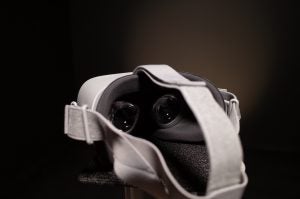
Both Google’s Daydream and Samsung’s Gear VR are compatible with a variety of phones offering different screen resolutions, and the Oculus Go compares very favourably with these.
It’s 2560 x 1440 screen resolution is on a par with the Samsung Galaxy S7 or Google Pixel XL, and while it can’t compete with the Samsung Galaxy S9 (2960 x 1440) or Pixel 2 XL (2880×1440), these phones only win out on resolution because of their slightly wider aspect ratio.
With VR, the refresh rate of a screen – the number of times a second that its image changes – is very important. Too little and the world will appear to ‘stutter’, ruining the immersion. The refresh rate of the Oculus Go tops out at just 72Hz, and a lot of games will run at 60Hz, which is far less than the 90Hz standard of PC headsets, although better than the majority of 60Hz phone screens.

The screen itself is an LCD panel, which has a bit of a mixed reputation for VR. OLED is commonly thought of as being the superior display type for headsets, but this isn’t an area we found particularly troubling with the Go.
The single biggest issue with all this tech is that the battery life just isn’t good enough. With a maximum of 2.5 hours of use (less, if you’re playing a game), this is a device you’ll want to keep charged, especially when it takes around 3 hours to fully top it up from empty.
We get that not many people are going to use a VR headset for 2.5 hours at a time, but for us this is about making sure the headset has power when we need it – and this rate of battery life means paying attention to charge levels more than we’d like. Oculus is also pushing the headset as being a great way of watching movies, which will obviously eat into that time fairly quickly.
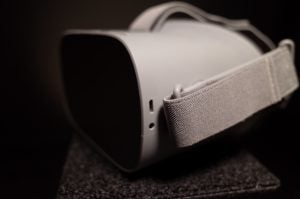
Charging is handled by a micro-USB port, and there’s a 3.5mm jack for using your own headphones
Oculus Go – Sound
Audio duties are handled by a pair of speakers on the sides of the headset, which direct sound into your ears. The Oculus Go is surprisingly effective at positional audio, but we’d be lying if we said it was the best way to use the headset.
Much more effective was plugging a pair of headhphones into the 3.5mm jack. On-ear or over-ear headphones will be a little bulky, but earbuds work just fine.
Oculus Go – Setup
Since this is essentially a mobile VR headset, the Oculus Go’s setup is far simpler than its PC siblings. There’s no messing around with having to plug devices in via USB and downloading drivers. Instead, you pair the headset with your phone to complete the majority of the installation.
The phone portion of the setup is handled via the Oculus App, which pairs with the headset over Bluetooth to get its Wi-Fi login details and install games.
You can do much of the setup from inside VR, but we found it easier to set games to download via the app.
Overall, setup proved a fairly seamless process. Our one misstep came with the setup of the Netflix app. With the app asking us to enter our password from inside virtual reality, there was no easy way to copy it out of our password manager and into the experience. In future, we’d love to be able to enter the password from the companion app.
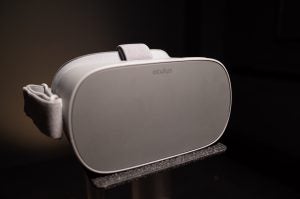
Oculus Go – Apps, videos and gaming
At launch, Oculus advertises that the Go has more than 1000 apps, games, and movies for you to play, and that 100 of these are either new or have been significantly updated for the new headset.
What this means in practice is that much of what’s currently available on the Oculus Store was originally made for the Gear VR. This means experiences such as Blade Runner 2049 Replicant Pursuit work, but they don’t make full use of the Go’s motion controller, the equivalent of which was an optional accessory with the Gear VR.
Boot into some games that have been optimised for the Go and what you’ll find is quite impressive.

Titles such as Coaster Combat are good with their simple controls and bright, chunky visuals. It’s a seated experience (so you don’t notice the lack of positional tracking), and all the action takes place in front of you, which means you never have to awkwardly crane to look behind you. The refresh rate was also rock-solid.
While the visuals in a game such as this aren’t nearly as detailed as what’s possible on a gaming PC’s VR headset, the resolution means that everything is nice and clear.
That said, the Oculus Go has the same problems with text as the Rift and Vive. We enjoyed playing the game B-Team with its endless runner take on VR, but it relied on pages and pages of text in its tutorials, and the headset just doesn’t have the resolution to make this easy to read.

In a similar vein, we thought that Anshar Online didn’t play into the strengths of the headset. The third-person space shooter has you flying around shooting enemies, but requires you to be able to turn a full 360 degrees to be able to move backwards and forwards through the world. That’s fine for a room-scale PC VR experience, but it’s a little more tricky when you’re sitting down with a mobile VR headset.
The overall impression is that games designed with the Oculus Go’s limitations in mind felt great. Sure, their graphical fidelity wasn’t particularly high, but the motion-tracking, resolution and refresh rate meant that classic sense of VR immersion was present.
But for games where the hardware’s limitations weren’t considered, we became far more aware of the sensation of wearing a VR headset. To a certain extent, this was also true of games running at 60Hz rather than 72Hz.

Oculus Rooms allows you to hang out with friends and watch movies or play games (shown here)
In addition to gaming content, Oculus is keen to emphasise the video-watching abilities of the Go – but these feel a little early and disjointed.
There’s Oculus Videos, where you can watch 360 videos from a variety of different media organisations, or Oculus Gallery where you can view your own photos and videos from Facebook, Instagram, or your device’s internal storage. Finally, Oculus Spaces – where you can chat and play games with friends – also includes the ability to watch videos and view photos.
In the coming months Oculus will be launching Oculus TV and Oculus Venues. The former will act as a portal to TV content, while the latter will allow you to watch live comedy and music shows with friends.
It’s a little difficult to keep track of what’s available, and how you can interact with each of the different viewers. We’d love to be able to watch Netflix with friends, but at the moment that whole experience is relegated to a separate app that doesn’t support multiple users.
It’s a shame, because using the Oculus Go to watch movies on a big virtual screen is super-fun, and we could even see ourselves using it to pass time on a flight. We have no doubt that the software will improve over time, but at the moment it definitely feels early.
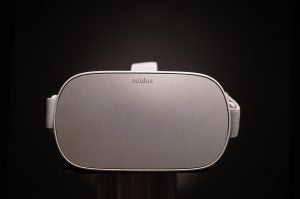
Why buy the Oculus Go?
You should buy the Oculus Go if you want a budget-friendly way to get into VR, and you don’t have a phone that supports a mobile VR solution such as the Gear VR or Google Daydream.
That said, even if you do have such a phone the Oculus Go could still be an excellent choice. Having a separate phone and VR headset rather than having to constantly detach the phone from a headstrap when you need to use it feels more ideal.
But the problem is that there’s no one app that justifies the purchase. Like buying a new console on launch day, you’d be buying the Oculus Go on the promise of continued support down the line.
That’s not to say that the experiences available now are poor; in fact, many are pretty fun. However, there’s nothing here that you’ll find yourself playing for hours on end (although the device’s maximum of 2.5 hours of battery life could prove to be a more long-term problem here).
Verdict
There’s a very solid foundation here for a great VR experience, with good motion tracking and a decent screen, but the Oculus Go doesn’t quite have itself a killer app at launch.


